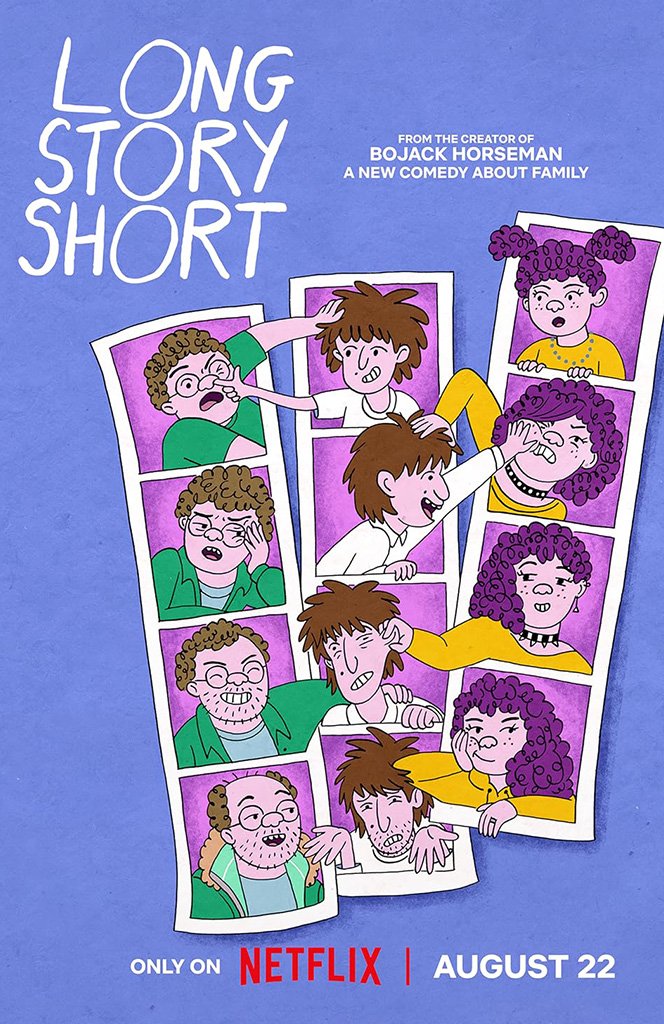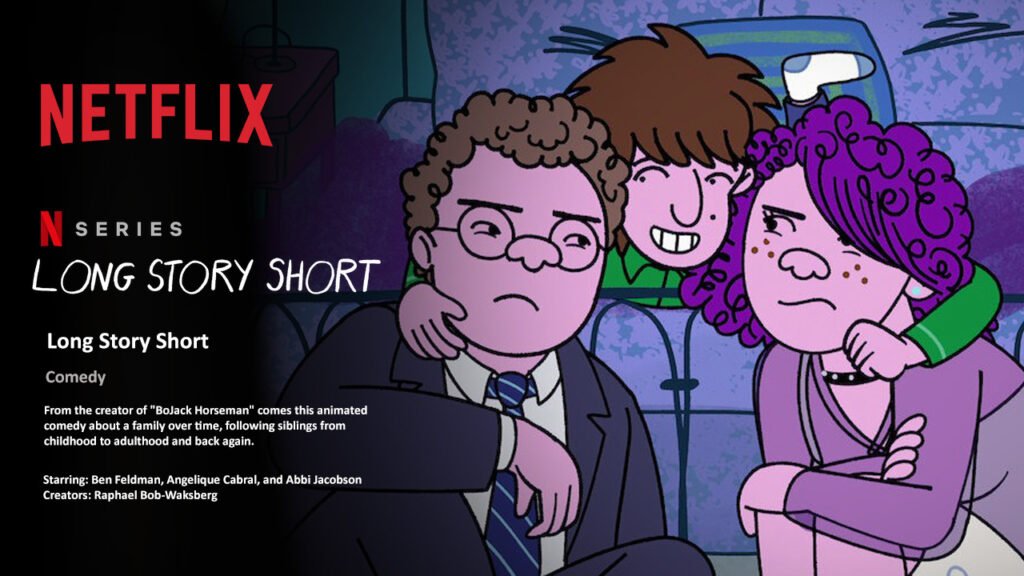Long Story Short is an animated family dramedy that spans decades in the lives of the Schwooper siblings—Avi, Shira, and Yoshi—capturing the humor, heartbreak, and chaos of growing up together. Through an inventive time-jumping narrative, the Long Story Short series explores how childhood moments, inside jokes, rivalries, and emotional wounds ripple through their adult lives.
As the siblings face everything from awkward crushes and petty fights to career struggles and family grief, the show uncovers the bittersweet truth of family: no matter how much changes, some things never do.Long Story Short Created by BoJack Horseman’s Raphael Bob-Waksberg, Long Story Short is a raw, relatable, and deeply funny portrait of siblinghood in all its messy glory.
Table of Contents

Introduction
Long Story Short is a heartfelt and hilarious animated Netflix Long Story Short series from Raphael Bob-Waksberg, the creator of BoJack Horseman. Premiering on August 22, 2025, the show follows the intertwined lives of three siblings—Avi, Shira, and Yoshi Schwooper—as they navigate childhood, adulthood, and everything in between.
Told through clever time jumps and sharp emotional insights, the Long Story Short series captures the comedy and chaos of growing up, growing apart, and somehow still being family. With its blend of laugh-out-loud moments and touching nostalgia, Long Story Short offers a fresh take on sibling bonds, memory, and how the past always finds its way into the present.
Release Date
Official Release Date: August 22, 2025
Streaming Platform: Netflix
Season 1 Episodes: 10
The Long Story Short series premieres globally on Netflix, bringing fans a nostalgic, funny, and emotionally rich look at family life—just in time for late-summer binge-watching.
LONG STORY SHORT OFFICIAL TRAILER NETFLIX
Main Cast & Voice Roles Long Story Short
Here’s a detailed list of the main voice cast and their roles in Long Story Short, along with character descriptions and casting notes:
Ben Feldman as Avi Schwooper
- The eldest sibling, often seen as the responsible one—but he’s riddled with anxiety and indecision.
- Ben brings warmth, wit, and emotional complexity to a character trying to hold the family together while quietly falling apart.
Abbi Jacobson as Shira Schwooper
- The sharp-tongued middle child who is fiercely independent yet deeply sensitive.
- Abbi’s voice balances sarcasm and vulnerability, capturing the inner conflict of someone who says she doesn’t care—but cares a lot.
Max Greenfield as Yoshi Schwooper
- The free-spirited youngest sibling, always chasing adventure, approval, or a new identity.
- Max infuses Yoshi with charm and chaos, portraying him as both the comic relief and emotional wildcard of the trio.
Lisa Edelstein
- Voices the Schwooper matriarch, a blend of emotional distance and unexpected wisdom.
- Her voice adds gravitas and dry humor, grounding the family’s more dramatic moments.
Paul Reiser
- Plays the father, offering old-school wisdom mixed with emotional repression and dad jokes.
- Reiser brings a comforting but flawed authority to the role.
Angelique Cabral
- Portrays Avi’s wife, a voice of reason outside the Schwooper chaos—struggling to balance love and frustration.
- Offers a grounded, empathetic voice that reflects the pressures of marrying into a complicated family.
Nicole Byer
- Voices multiple comedic side characters, including coworkers, teachers, and therapists.
- Her vibrant delivery provides high-energy comic moments across various timelines.
Guest Voices
- Dave Franco – College version of one of the siblings’ best friends.
- Michaela Dietz – As a recurring cousin with deep emotional ties to a family secret.
Key Themes
Long Story Short dives deep into the complexities of family life using humor, heart, and time-hopping storytelling. Here are the central themes explored throughout the Long Story Short series:
Sibling Dynamics
- Love, rivalry, loyalty, and resentment—this Long Story Short series captures the full spectrum of emotions between brothers and sisters over decades.
- It shows how siblings can grow apart, clash, and yet always remain connected in inexplicable ways.
Memory and Time
- Non-linear storytelling reflects how we remember (and misremember) childhood and family events.
- Past and present constantly interact, revealing how early moments shape adult choices.
Emotional Inheritance
The show explores how families pass down not just traditions, but traumas, roles, and behavioral patterns.
- Characters struggle with inherited expectations and emotional baggage.
Humor as Survival
- Comedy is woven through even the most painful memories—showing how laughter can be both a defense mechanism and a bridge.
- Inside jokes become anchors across time.
Growth and Regret
Each sibling is on their own path of growth, but not without mistakes, misunderstandings, and moments of deep regret.
- The show respects the idea that people change—but some wounds stay tender.
Family as Identity
- Even as the characters build lives of their own, they’re constantly pulled back into the gravitational field of family.
- The show questions: Who are we without the people who raised—and hurt—us?
Challenges & Environments
Though Long Story Short is animated, its emotional depth and layered storytelling create vivid “environments” both literal and psychological. The real challenge in this series isn’t survival—it’s connection.
Emotional Challenges
- Communication Breakdown
Siblings often talk at each other, not with each other. Misunderstandings from childhood persist into adulthood, even when everyone “should know better.” - Unresolved Grudges
Long-held resentments simmer beneath casual banter. The smallest moments—missed birthdays, ignored feelings—snowball into deep emotional distance. - Competing Identities
Each sibling is fighting to define themselves outside the family, while constantly being pulled back in by shared history and expectations. - Shifting Power Dynamics
Childhood hierarchies (eldest/responsible, middle/forgotten, youngest/spoiled) still influence adult decisions and relationships, often subconsciously.
Environmental Settings
- The Childhood Home
Visited across different timelines—once vibrant, later quiet or cluttered with memory. It’s both a safe haven and a pressure cooker. - Flashback Worlds
Vividly animated school cafeterias, awkward birthday parties, bat mitzvahs, and basement hideouts recreate the chaotic magic of growing up. - Adulthood Spaces
Apartments, therapy offices, kitchens after midnight—each setting reflects the character’s emotional state at that moment in life. - Holidays and Family Gatherings
Repeated settings for conflict, comedy, and reluctant reconciliation. Thanksgiving and birthdays often serve as emotional battlegrounds.
Narrative Environment (Temporal Fluidity)
- The story jumps through decades, blending time periods to show cause and effect.
- Past arguments play out next to their present-day echoes, creating an emotional maze the viewer must (and wants to) untangle.
Visual Style – Long Story Short
Though Long Story Short is an animated series, its visual storytelling mirrors the emotional complexity and grounded realism of a live-action family dramedy—infused with surreal moments that reflect memory, growth, and nostalgia.
Animation Style
- 2D Animation with a Hand-Drawn Feel
The Long Story Short series uses soft outlines and warm, muted color palettes to evoke memory and sentimentality—like a storybook or family photo album in motion. - Stylized, Not Cartoonish
Characters are expressive and detailed, but not exaggerated. This isn’t slapstick—it’s emotionally grounded, subtle, and intimate. - Time Jumps with Visual Cues
Each time period (childhood, adolescence, adulthood) has a distinct visual tone:- Childhood scenes: Brighter, warmer colors; rounder character designs; imaginative transitions.
- Adult scenes: Cooler tones, sharper lines, and more subdued animation to reflect real-life complexity.
- Memory sequences: Slight blurring, sepia filters, or floating transitions to show the imperfection of recollection.
Lighting & Color Palette
- Emotional Color Theory
- Warm yellows and soft pinks for nostalgic or joyful memories.
- Pale blues and greys during emotional distance or regret.
- Saturated reds and purples during conflict or dramatic tension.
- Naturalistic Lighting
Sun-drenched windows, flickering TV glow, and dim hallway lights create cinematic moods—like a live-action indie film.
Cinematic Techniques in Animation
- Split Screens: Used to show multiple timelines, sibling reactions, or how each character processes the same moment differently.
- Montages: Rapid-fire emotional sequences that cross time, showing repeated family patterns or growth arcs.
- Symbolic Visual Metaphors: Objects (a toy, a necklace, a photo) appear across episodes as silent witnesses to the siblings’ evolution.
Environmental Design
- Living Spaces Evolve Over Time:
From childhood bedrooms to adult apartments, homes reflect growth, clutter, emotional residue, and shifting family dynamics. - Backgrounds as Memory Triggers:
Backgrounds aren’t just static—they’re layered with meaning. A hallway wall may hold family photos that appear in flashbacks, or a familiar crack in the paint may transport a character (and viewer) to another moment in time.
Fan Anticipation & Critical Reception
Fan Anticipation
- High Expectations from BoJack Fans
As the brainchild of BoJack Horseman creator Raphael Bob-Waksberg, the series has drawn intense interest from fans of emotionally intelligent animation. Social media buzz highlights hopes for a show that balances humor, trauma, and healing—just like BoJack, but more family-focused. - Trailer Reactions
The official trailer sparked positive responses across YouTube and Reddit: “It looks like BoJack Horseman meets The Wonder Years. I’m not ready to cry over cartoons again—but here we go.”
“This already feels too real. I’m going to watch it twice and call my siblings after.”
Fans particularly praised the authentic voice acting and unique visual tone. - Early Netflix Promotion
Netflix heavily featured the series in its “Next on Netflix: Adult Animation” campaign, labeling it one of their “most emotionally layered animated premieres of the year.” - Pre-Release Renewal Buzz
The announcement of Season 2 before Season 1 even aired further fueled fan confidence in the show’s storytelling strength.
Critical Reception (Early Reviews & Insider Reactions)
- Vulture: “If BoJack was about existential loneliness, Long Story Short is about the pain and humor of being stuck with people you love.”
- The Wrap: “A masterclass in emotional pacing and visual nostalgia. It might be the best animated show of 2025.”
- GamesRadar+: “Remarkably relatable… capturing the unspoken rules, jokes, and wounds that live between siblings.”
- Rotten Tomatoes (Projected Score):
Early critic screenings suggest a debut score in the 90–95% Fresh range. - Metacritic (Early Estimate):
Likely to land in the 80s, praised for originality, voice performances, and narrative structure.
Community Sentiment
- On Reddit and X (Twitter), users are calling it: “The next great binge-worthy cry-laugh show.”
“An animated This Is Us for our generation.”
Production Details
Streaming Platform
- Netflix
- Release Date: August 22, 2025
- Format: 2D Animated Series
- Genre: Adult Animation / Family Drama-Comedy
- Episodes (Season 1): 10
- Renewal: Season 2 already confirmed pre-launch
Creator & Showrunner
- Raphael Bob-Waksberg
- Known for: BoJack Horseman
- Creator, head writer, and executive producer
- Infuses the series with time-bending emotional realism, layered humor, and bittersweet storytelling
Animation Style & Studio
- Studio: ShadowMachine
- Known for: BoJack Horseman, Tuca & Bertie, Robot Chicken
- Supervising Producer / Art Lead: Lisa Hanawalt
- Brings her signature whimsical yet grounded design sensibility
- Emphasizes visual metaphors, expressive character design, and nostalgic set pieces
Executive Producers
- Raphael Bob-Waksberg
- Lisa Hanawalt
- Noel Bright & Steven A. Cohen (Tornante Television)
- Corey Campodonico & Alex Bulkley (ShadowMachine)
Writing Team – Season 1
- Mehar Sethi (BoJack Horseman, Always Sunny)
- Jordan Young (Drawn Together, Bojack)
- Kelly Galuska (Tuca & Bertie)
- Keyonna Taylor, Laura Donney, Rachelle Williams-Benary, Elijah Aron, Taryn Englehart
Music & Sound
- Composer: TBA (Expected to follow an indie-acoustic emotional score format)
- Sound design integrates ambient tones and nostalgic cues to support transitions between timelines
Narrative Format & Timeline Design
- Time-Jumping Narrative
Each episode shifts between the past (childhood/adolescence) and present (adulthood), highlighting how emotional patterns repeat and evolve - Story Arcs
Storylines focus on individual growth, unresolved trauma, sibling bonds, and the ways small moments define a lifetime
Creator Profile – Raphael Bob-Waksberg
Raphael Bob-Waksberg
Role: Creator, Showrunner, Executive Producer of Long Story Short
Notable For:
- Creator of the critically acclaimed animated series BoJack Horseman
- Known for blending dark humor, emotional storytelling, and meta-narratives in adult animation
- Strong collaborator with artist and producer Lisa Hanawalt
Previous Works
- BoJack Horseman (Netflix)
- Role: Creator & Executive Producer
- Acclaimed for its sharp wit, social commentary, and honest exploration of mental health, addiction, and fame
- Widely considered one of the most important adult animated shows of the 2010s
- Undone (Amazon Prime)
- Role: Producer
- A rotoscope-animated sci-fi drama exploring time, trauma, and consciousness
- Tuca & Bertie (Producer, Netflix/Adult Swim)
- Executive produced this surreal slice-of-life show, created by Lisa Hanawalt
- Focused on women’s experiences, anxiety, and friendship through abstract and comedic storytelling
- Other Credits
- Voice actor and cameo performer in multiple animation projects
- Occasional guest writer on Robot Chicken and other sketch series
Style & Themes
- Emotional Honesty in Animated Form
Often uses animation to express emotional truths that would be harder to show in live-action - Recurring Themes:
- Dysfunctional relationships
- Time and memory
- Mental health
- Regret, healing, and growth
- Narrative Devices:
- Nonlinear storytelling
- Internal monologue and voiceovers
- Surreal sequences tied to emotional states
All-Over Review
Long Story Short is a standout adult animated series that successfully blends nostalgia, humor, and heartbreak into a deeply human story of siblinghood. Created by Raphael Bob-Waksberg (BoJack Horseman), the show delivers on the emotional complexity fans have come to expect—this time through the lens of family rather than fame or existential dread.
Told through nonlinear timelines, the series jumps between childhood chaos and adult consequences with surprising elegance. Each episode peels back another layer of long-held grudges, inside jokes, and “little t” traumas that every viewer will recognize. The writing is tight, the voice acting (Ben Feldman, Abbi Jacobson, Max Greenfield) is natural and emotive, and the animation is soft and evocative—serving the emotional tone without overwhelming it.
What sets Long Story Short apart is its empathy. It doesn’t vilify or idolize its characters—it simply lets them be messy, flawed, and trying their best. The humor is organic and bittersweet, with plenty of laugh-out-loud moments that quickly shift into moments of genuine reflection.
Some may find the pacing slow or the time jumps occasionally disorienting, but that’s also part of the point: memories don’t unfold neatly, and neither do relationships.

